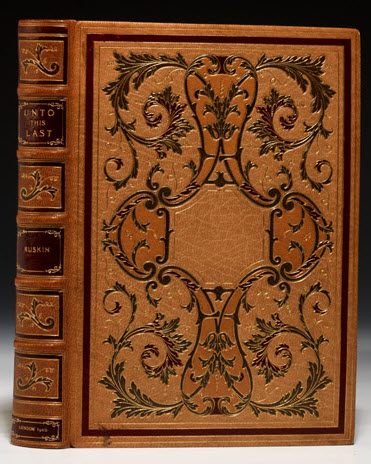Notes»
▲1 Even though
Unto This Last is great writing, it is difficult reading for most of us today. Ruskin's sentences are elaborately constructed, and his arguments are often complex. Furthermore, he refers to events about which we likely no little or nothing, and he assumes his readers are intimately familiar with the Christian Bible and Greek and Roman literature.
▲2 This edition unlocks the door for modern readers and points out the best things in the room. Because this is a QuikScan edition, the text is carefully divided into (hyperlinked) sections, and for each section there is a summary. The summaries give you the gist of each section before you tackle Ruskin’s Victorian prose. Plus, if a section does not seem interesting, you can just read the summary and proceed to the next section. If you read both the summaries and the full text, retention increases dramatically and (because of more efficient processing), reading time is no greater than if you read the text only.) You get the extra retention “for free.” For more detail,
see the research on QuikScan.
Another feature of QuikScan is a system of hyperlinked numbers that lets you easily jump back and forth between any of the ideas in a summary and the place in Ruskin’s text where that idea is fully discussed. If something in a summary intrigues you, you jump directly to the corresponding location in the text.
▲3 Yellow highlighting is used to indicate passages in Ruskin’s text that we regard as especially important for mainstream readers. Sepia font color is used for less important passages that you may want to skip. This “must read“ or ”skippable” status is also shown in the summaries, but we think you should read each summary completely, even the parts in sepia. The yellow highlighting and sepia font color can be turned off in the Viewing Options for each chapter. This edition also provides two short, lively background essays, “About John Ruskin” and “About
Unto This Last.” and complete notes written for the modern reader.
Notes»
▲1 Ruskin's wrote his own footnotes, some brief and some quite lengthy, and so there are footnote numbers in the text. A few of Ruskin’s footnotes are “must read” and so the footnote numbers are marked in yellow. Skippable footnotes are in sepia.
The Notes page for each chapter contains both Ruskin’s footnotes and many editorial footnotes that explain confusing parts of the text. The editor’s notes are not marked in the text. But if you see something confusing, follow the link to the Notes page for that chapter: there is probably an explanation.
▲2 Remember that the division of the essays into sections and the section titles were added as part of the QuikScanning. Ruskin did not use headings. Ruskin did, however, add his own numbers to mark divisions of the text. His divisions, as far as I can determine, are idiosyncratic. Wilmer, in his edition of Ruskin’s works, leaves them out. In this edition, these numbers (taken from the Cook and Wedderburn Library Edition) appear in parentheses at the end of any paragraph where Ruskin placed a number. Also, these paragraphs are slightly indented. Scholars will find these numbers helpful if they use this edition in conjunction with a scholarly edition or a secondary source that has retained Ruskin's numbers.
▲3 To assist a significant group of low-vision readers, there is a high-contrast setting in the Viewing Options that turns the background of each page a highly saturated yellow. Other low-vision readers can increase the size of the text by adjusting their browser settings. QuikScan has been extensively tested with both blind and low-vision readers. They have responded positively or very positively to QuikScan and enjoy improved retention.
▲4 This text of this edition of
Unto This Last is derived from the digitized version of the George Allen edition of 1904 (Sunnyside, Orpington, Kent) prepared by the University of Virginia Electronic Text Center. I have made small changes in the punctuation, including using double quotes (more familiar to the modern reader) and spacing around dashes. Obvious scanning errors were corrected.

